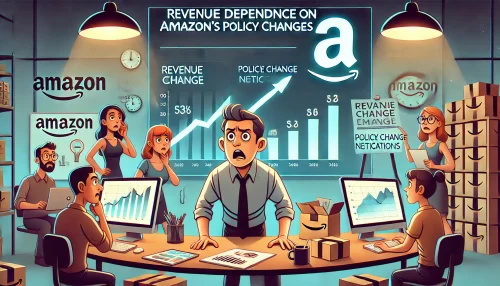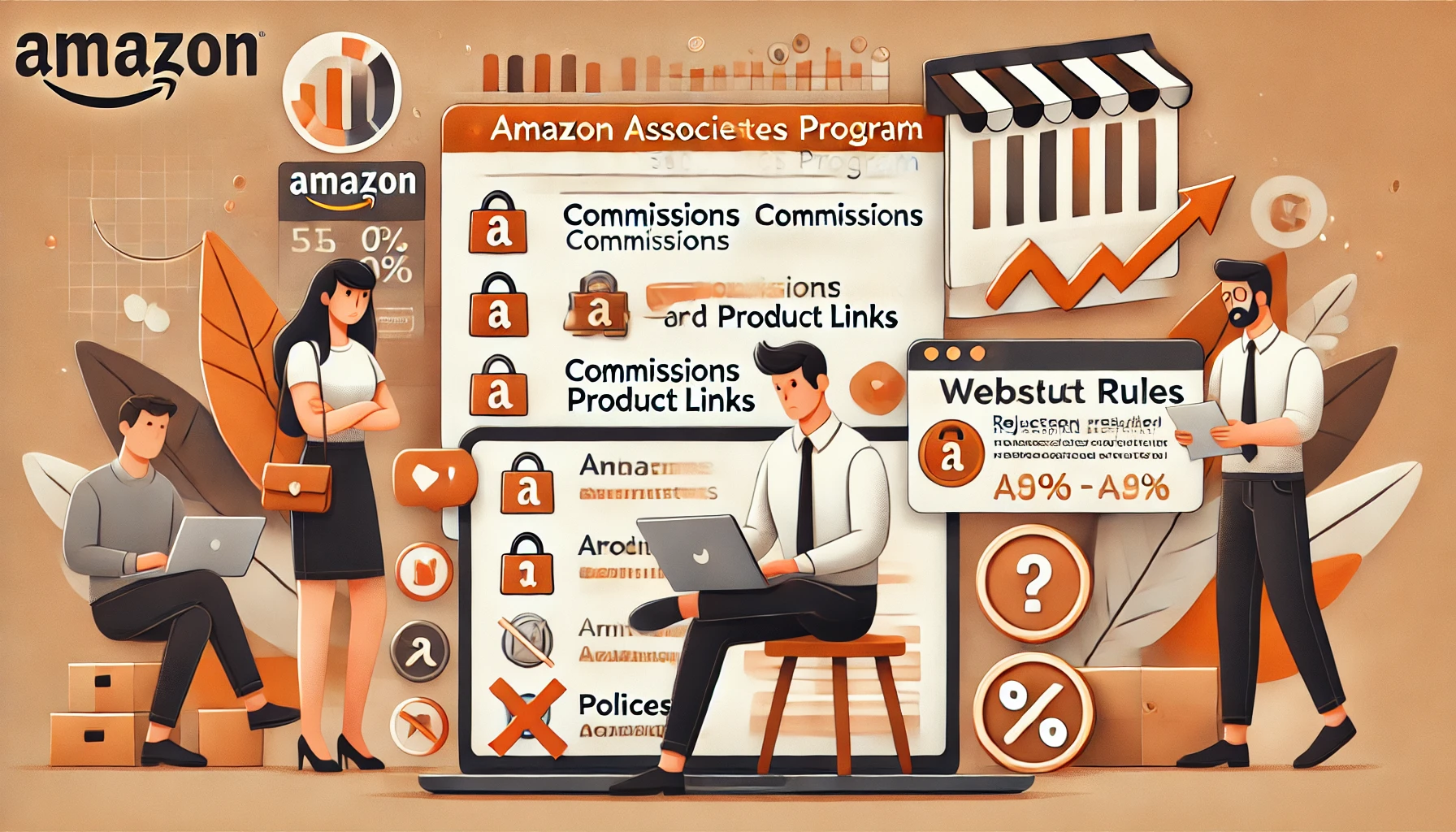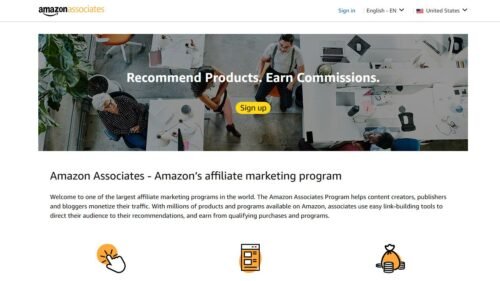Table of Contents
Are you considering joining the Amazon Associates Program but worried about its limitations? How do its restrictions on commissions, payouts, and marketing impact your potential earnings? If you’re planning to make money with Amazon, you need to be aware of the hurdles that could affect your success.
In this guide, we’ll break down the key limitations, including compliance requirements, payout rules, and policy changes, to help you navigate the program effectively. Stick around, and you’ll learn how to overcome these challenges and even explore alternatives to diversify your affiliate income. Ready to dive in? Let’s get started!
Overview of the Amazon Associates Program
The Amazon Associates Program is a popular affiliate marketing platform, offering creators, bloggers, and marketers a chance to earn commissions through referral sales. Let’s explore how it works and why it’s an attractive option for many online businesses.
How the Amazon Associates Program Works
The program is simple: you earn commissions by promoting Amazon products using unique affiliate links. Whenever a user clicks on your link and makes a purchase, you get a percentage of the sale. Sounds straightforward, right? While the basics are easy, there are key details that can affect your earning potential.
- Sign-Up and Approval: To start, you create an Amazon Associates account. Amazon reviews your website or platform to ensure it meets their standards. Approval typically happens quickly if you comply with the guidelines.
- Affiliate Links: Once approved, you can generate affiliate links for millions of products using Amazon’s affiliate tools. These links track clicks and sales through cookies (typically lasting 24 hours).
- Commission Structure: Different product categories come with varying commission rates. Electronics, for example, often have lower commissions than fashion or beauty products. Understanding this structure is essential to maximizing earnings.
- Performance Monitoring: Amazon’s dashboard allows you to track clicks, conversions, and earnings in real time. However, it’s important to note that delays in tracking can occur, and monitoring metrics regularly is key to identifying issues early.
In my experience, while the mechanics of the program are straightforward, success depends on how effectively you integrate those links into your content without coming off as overly promotional.
Benefits of Joining the Amazon Associates Program
You’ve probably heard success stories of people earning passive income with Amazon. But what exactly makes the Amazon Associates Program so appealing?
- Massive Product Range: With millions of products available, you can cater to virtually any niche. Whether you’re a tech blogger or a beauty influencer, there’s something for you to promote. The flexibility allows for targeted affiliate campaigns based on your audience’s interests.
- Trust in Amazon’s Brand: Amazon’s global reputation works in your favor. People are more likely to purchase from Amazon compared to lesser-known stores, meaning higher conversion rates for you. When I recommend a product, knowing it’s backed by Amazon’s customer service often reassures my readers.
- Low Barrier to Entry: Unlike other affiliate programs that require a large following or extensive experience, Amazon Associates is beginner-friendly. Even small websites or new blogs can apply and get approved, making it accessible for many aspiring affiliates.
- Diverse Earning Potential: Amazon’s commission structure isn’t limited to just the products you promote. If someone clicks your affiliate link and purchases additional items—yes, even unrelated products—you’ll earn commissions on those too.
- Multiple Monetization Methods: You can incorporate Amazon affiliate links into blog posts, email campaigns, YouTube videos, or even social media. This versatility means you don’t need to rely solely on one content format.
Despite its benefits, relying solely on this program might not be sustainable long term due to potential commission rate reductions. That’s why many affiliates diversify their income streams.
Expert Tip: Make sure you promote products within categories with higher commission rates whenever possible. For example, home improvement and fashion often have better payouts compared to electronics.
Common Limitations You Should Be Aware Of

While the Amazon Associates Program offers significant potential, it comes with several limitations that can directly affect your earnings. Understanding these challenges is key to creating an effective strategy and minimizing frustrations.
Minimum Payout Thresholds and Delays
Earning commissions is exciting—until you realize you might have to wait longer than expected to see your money. The Amazon Associates Program enforces a minimum payout threshold and specific conditions before you receive your earnings.
For many participants, this threshold is $10 for electronic payments and $100 for physical checks. If you don’t meet it, your earnings will roll over to the next month. This can be frustrating, especially if your website generates small but consistent commissions. On top of that, payouts can be delayed due to Amazon’s 60-day verification period to ensure returns or cancellations do not impact your earnings.
Let’s say you earned $200 in commissions in January. You won’t see that money until March because of the review process. I’ve found that for smaller affiliates, this waiting period can feel like a setback, especially if you’re relying on consistent cash flow.
To avoid the strain of delays, you could focus on generating high-ticket sales that meet the payout threshold faster. Promoting products with higher commissions, like electronics or home appliances, can help bridge the gap.
Pro Tip: Set realistic expectations for when you’ll receive payments. Understanding Amazon’s timeline helps reduce surprises and lets you plan finances accordingly.
Geographical Restrictions for Participants
If you’re outside certain countries, joining the Amazon Associates Program might not be as straightforward. Some regions are excluded or limited in the scope of what affiliates can access, creating hurdles for global participation.
Amazon primarily supports affiliates from major countries like the United States, Canada, and the United Kingdom. If you live in a country not officially supported, you could face challenges with account approval or restricted payment methods. For example, affiliates in unsupported regions may not be able to receive direct bank transfers or may be limited to gift card payouts.
Additionally, international traffic doesn’t always translate to commissions unless you use Amazon’s OneLink feature. OneLink is designed to help affiliates earn across multiple Amazon regions, but the setup process can be confusing and requires linking individual country-specific accounts.
For affiliates targeting global audiences, this can limit the program’s effectiveness. Imagine you run a successful blog that attracts readers from India and Australia, but only your US-based sales contribute to earnings. That can leave significant revenue on the table.
Commission Rate Caps and Limitations by Category
Not all products generate equal commissions, which is one of the most common pain points in the Amazon Associates Program. Depending on the product category, you might earn as little as 1% or as much as 10% per sale, making category selection critical for profitability.
For instance, luxury beauty products typically have higher commission rates compared to electronics, which are capped around 3%. Many affiliates mistakenly assume all products provide the same return, only to be disappointed when promoting high-ticket electronics with low commissions.
Another major limitation is that certain services or digital products, such as Amazon Prime subscriptions or Kindle Unlimited trials, generate fixed bounties instead of percentage-based commissions. While bounties can provide consistent payouts, they often don’t scale as well compared to commission-based models.
It’s important to regularly check Amazon’s commission rates since they occasionally change. I’ve seen affiliates lose significant income when Amazon lowered rates without warning.
Product Return Policies and Their Impact on Commissions
When customers return items, Amazon deducts those sales from your total earnings. This is a major limitation, especially for affiliates promoting high-return products like clothing or electronics.
Let me break it down for you. If you earn $50 in commissions on a product, but the buyer returns it within Amazon’s return window (usually 30 days), that $50 will be clawed back from your pending payout. For affiliates heavily reliant on high-volume sales, frequent returns can significantly impact monthly earnings.
Certain product categories, such as fashion or footwear, naturally experience higher return rates. If you frequently promote products in these areas, expect fluctuations in your income. On the other hand, categories like books and household items typically have lower return rates, making them more reliable for sustained earnings.
One solution I recommend is analyzing past sales to identify patterns in returns. If you notice a particular product or category is resulting in frequent clawbacks, you can adjust your strategy.
Best Practice: Promote products with lower return rates or highlight products that have positive customer reviews. Happy customers are less likely to return items, protecting your commissions.
Compliance Requirements and Guidelines
The Amazon Associates Program has strict compliance rules, and violating them can result in commission losses or account termination. Knowing the key requirements ensures you stay within the guidelines and protect your earnings.
Disclosure Rules for Affiliate Links
One critical aspect of compliance is disclosing affiliate relationships. Amazon requires affiliates to inform their audience whenever they use affiliate links, and failing to do so could lead to penalties.
The Federal Trade Commission (FTC) also mandates that affiliates disclose their relationship with Amazon in a way that’s clear and easy to understand. A simple line, like “As an Amazon Associate, I earn from qualifying purchases,” is usually sufficient, but it must be prominently displayed near the links. The goal is to maintain transparency, ensuring that users know when a recommendation includes a financial incentive.
Disclosures aren’t just about legal requirements—they build trust. When readers feel that you’re being honest, they’re more likely to take your recommendations seriously. From what I’ve seen, transparent disclosures can actually boost conversions, as they demonstrate integrity.
Be sure to include disclosures across multiple platforms, whether you’re using blogs, videos, or social media. Amazon’s Operating Agreement states that even Instagram posts or YouTube descriptions must have proper disclaimers. Neglecting this requirement could result in commissions being withheld.
Prohibited Marketing Practices
Amazon’s strict guidelines prohibit certain promotional tactics that may seem tempting, especially for beginners looking to increase traffic. For example, you cannot use paid ads that direct users straight to Amazon using your affiliate link.
Amazon also prohibits affiliate links in offline channels like print media or email newsletters unless you get approval. You can’t cloak links to disguise their affiliate nature, nor can you use misleading promotions to encourage purchases. Spamming affiliate links across forums or irrelevant websites is another common violation that many new affiliates don’t realize can get them banned.
If you’re thinking of driving traffic with incentives such as discounts or giveaways, be cautious. Amazon does not allow unauthorized promotions of its products. Instead, focus on building organic traffic and using approved methods like blogging or video reviews.
Tip: Always review Amazon’s updated guidelines. The rules can change frequently, and staying informed is the best way to avoid costly mistakes.
Website Content Restrictions
Amazon carefully monitors the content of affiliate websites to ensure they align with its standards. Affiliates promoting illegal, offensive, or deceptive content risk immediate termination. Even websites that host pirated material, hacking content, or explicit content will get banned.
Amazon also emphasizes that affiliate sites must provide genuine value. If your site is filled with low-quality, duplicate content that merely copies product descriptions without adding unique insights, you may run into problems. To stay compliant, create original product reviews, helpful guides, and comparison articles.
Certain niches, like firearms or adult products, are considered high-risk under Amazon’s guidelines and may face restrictions. If you’re in a restricted niche, check whether you can work around it legally.
Tracking and Reporting Challenges

Effective tracking is vital for optimizing affiliate performance, but the Amazon Associates Program comes with its own tracking limitations. Let’s explore how these issues arise and what you can do to improve accuracy.
Issues with Tracking Affiliate Sales
One of the most common challenges affiliates face is tracking discrepancies, which can result in untracked sales or underreported commissions. Amazon uses cookies to track user behavior, and if those cookies expire or are blocked, the sale might not be credited to your account.
For example, if someone clicks your affiliate link but doesn’t purchase until the next day, they need to complete the transaction within Amazon’s 24-hour cookie window. Once the window closes, any purchases won’t count toward your earnings. This is particularly problematic if you promote products with long consideration periods, such as high-ticket electronics or home appliances.
Additionally, browser settings, ad blockers, and cookie deletion can interfere with tracking. Imagine promoting a product, only to discover that many potential sales didn’t register due to technical issues. It can be discouraging, especially when you’ve invested significant effort in generating traffic.
Common Tracking Errors and Fixes
Tracking issues can stem from improper link setup or broken links that fail to direct users correctly. If you manually create affiliate links without Amazon’s Link Builder tool, you run the risk of errors. Even small mistakes, like an extra character in the link, can prevent Amazon from attributing sales to your account.
One major issue I’ve seen is affiliates placing Amazon links on third-party platforms that break or modify URLs, causing tracking failures. For example, social media platforms that shorten URLs can affect the tracking parameters of affiliate links.
To prevent tracking errors:
- Always use Amazon’s official link generator to create accurate links.
- Regularly test your affiliate links to ensure they lead to the correct product pages.
- Monitor reports in Amazon’s dashboard to spot discrepancies early.
Tracking errors aren’t always avoidable, but regular audits help minimize losses. If you notice significant discrepancies, reach out to Amazon’s support for clarification.
Expert Tip: Use link monitoring tools to ensure your URLs remain functional and generate reports that highlight broken or underperforming links.
Account Termination Risks and Causes
The Amazon Associates Program has strict rules, and violating them could lead to account termination and loss of earnings. Knowing the key risks helps you stay compliant and avoid unexpected suspensions.
Violations of Amazon’s Operating Agreement
Amazon’s Operating Agreement sets the foundation for what affiliates can and cannot do. Violating these rules—whether intentionally or accidentally—can result in severe penalties, including permanent bans.
One of the most common violations is improper use of affiliate links. Amazon requires that links are placed on approved websites, and they strictly prohibit sharing them in offline materials or within emails. For example, if you’re embedding affiliate links into newsletters without permission, you could be flagged for non-compliance.
Another major violation is link cloaking, where affiliates try to hide or manipulate the affiliate tracking information. Amazon considers this deceptive, and it can lead to immediate termination. Spamming affiliate links on unrelated forums or websites is also against the rules, so focusing on organic and relevant link placements is crucial.
In my experience, most issues arise when affiliates don’t read Amazon’s periodic updates to the Operating Agreement. Ignoring these updates could lead to unintentionally breaking rules you didn’t know had changed.
Low Performance Metrics as a Reason for Termination
Amazon regularly monitors affiliate performance, and accounts with consistently low conversions or traffic might face termination. If you’ve been accepted into the program but fail to generate sales within the initial 180 days, Amazon will close your account.
This requirement often catches new affiliates off guard. Many assume they have plenty of time to build traffic, only to lose their accounts because they didn’t hit their sales targets. Even after the initial grace period, Amazon continues to monitor performance metrics like click-to-conversion rates, total revenue, and traffic quality.
Low-quality traffic—often from non-targeted sources—can hurt your standing in the program. For instance, if you’re driving irrelevant clicks through spammy sources, Amazon may consider your account a liability. I’ve seen this happen when affiliates use clickbait tactics to increase traffic without generating meaningful conversions.
Improving performance starts with understanding your audience and tailoring product recommendations accordingly. Instead of driving random clicks, focus on traffic that’s likely to convert. High-quality content, such as product comparisons or “best of” guides, tends to result in better engagement and more sales.
Limited Control Over Affiliate Products and Pricing
One of the biggest challenges with the Amazon Associates Program is the lack of control affiliates have over product pricing and availability. This can impact your earnings, especially if prices change frequently or products go out of stock.
Price Fluctuations and Their Impact on Earnings
Amazon is known for frequent price changes, often due to dynamic pricing algorithms. While this benefits consumers, it can frustrate affiliates who promote products at a certain price only to see them drop—reducing their commission percentage—or increase, which discourages buyers.
For example, imagine you’re promoting a $200 kitchen appliance, and your blog specifies that price. If Amazon drops the price to $150, your commission is based on the lower amount. Even worse, if buyers see the price increase unexpectedly, they may abandon the purchase altogether.
Price changes also affect the trust between you and your audience. Visitors who click through expecting one price and encounter a different one may feel misled, even though the change isn’t your fault. To avoid this, it’s best to include disclaimers, like “prices are subject to change.”
Limited Influence on Product Availability
One of the downsides of the Amazon Associates Program is that affiliates have no control over product availability. If a popular item you’re promoting goes out of stock, you miss out on potential sales until it’s restocked—or you find an alternative.
This can be especially problematic during peak shopping seasons, like Black Friday or the holiday period, when products sell out quickly. If you’re promoting limited-stock items, sudden unavailability can severely impact your earnings. For example, I’ve seen affiliates promote a viral product, only to lose out on commissions because Amazon couldn’t replenish stock fast enough.
The issue becomes even more challenging with seasonal products. If your blog focuses on niche items, such as winter sports gear, you may face downtime when items are unavailable during off-seasons. To counter this, diversify the types of products you promote so that you’re not overly dependent on any single item.
Another tip is to monitor Amazon’s inventory status regularly and adjust your links when necessary. Tools like Amazon Link Checker can help detect when products go out of stock or listings are removed.
Best Practice: Have backup product recommendations ready. If a product you’re promoting goes out of stock, you can quickly update your content to point readers toward similar or alternative items, preventing lost commissions.
Revenue Dependence on Amazon’s Policy Changes

One of the biggest challenges with the Amazon Associates Program is its dependency on Amazon’s policies. Sudden changes in commission rates or program terms can significantly affect your earnings, which is why staying informed and adaptable is essential.
How Commission Structure Changes Can Impact Earnings
Amazon has a history of periodically changing its commission rates, and for many affiliates, these adjustments can be financially disruptive. Imagine earning 6% on home improvement products, only for Amazon to reduce it to 3%. If most of your traffic is targeted toward that category, you could experience a major drop in income without warning.
Amazon’s commission structure varies widely across categories. Some niches, like luxury beauty, maintain relatively high commission percentages, while others, like electronics, are capped at lower rates. While these changes are often announced in advance, they don’t leave much time for affiliates to adjust their strategies.
Let me break it down with an example. If your site primarily focuses on promoting laptops and related accessories (which typically have lower commission rates), a small reduction in percentage could make a big difference when promoting high-priced items. Earning 2% on a $1,000 laptop may already feel limiting, but if it’s dropped further, scaling your revenue becomes a major challenge.
A proactive approach is essential. Diversifying your niche and combining high- and low-commission categories can provide balance and reduce risk. Regularly reviewing Amazon’s commission updates can also help you plan ahead and avoid surprises.
Pro Tip: If you notice consistent drops in commission rates within your niche, consider shifting to high-performing categories or expanding into affiliate programs outside of Amazon.
Dealing with Sudden Program Updates
Amazon’s program policies are subject to frequent updates, and affiliates need to be flexible to stay compliant and maintain their revenue streams. These updates can include changes to payment thresholds, cookie durations, or even restricted marketing methods. Ignoring them can lead to missed earnings or even account termination.
For example, Amazon reduced its cookie window for affiliate tracking to 24 hours, which affected affiliates promoting products with longer buying cycles, like furniture or high-end tech. Affiliates who didn’t adapt quickly saw a decline in their commissions.
Another area prone to sudden updates is Amazon’s prohibited marketing practices. If Amazon decides to restrict a previously acceptable promotion method, such as paid search ads directing to product pages, affiliates using that strategy would need to pivot fast to protect their income.
I suggest creating a backup plan and exploring alternatives to Amazon so that you’re not fully dependent on its policies. Keeping track of updates on Amazon’s official announcements page can also help you stay ahead.
Best Practice: Build an email list or social media audience to maintain control over your marketing efforts, reducing the impact of Amazon’s policy shifts.
Alternatives to the Amazon Associates Program
While the Amazon Associates Program is popular, it’s not the only option for affiliates. Exploring other programs or diversifying income streams can provide more stability and better earning potential in the long run.
Other Popular Affiliate Programs to Explore
If you’re feeling restricted by Amazon’s policies, you’re not alone. Many affiliates have expanded into other programs with competitive payouts and fewer limitations. Here are a few you might consider:
- Awin: Known for its wide variety of merchants and higher commission rates in categories like fashion, fitness, and home décor. Unlike Amazon, many merchants offer cookie durations longer than 24 hours.
- CJ Affiliate (formerly Commission Junction): Ideal for affiliates looking to work with large brands in different niches. Its reporting tools offer more detailed insights than Amazon’s dashboard.
- Rakuten Advertising: This network offers partnerships with major retailers and often provides higher commissions for certain products compared to Amazon.
- eBay Partner Network: Great for affiliates targeting buyers interested in collectibles, tech, and auctions. eBay’s commission model is transaction-based and can sometimes be more rewarding than Amazon’s percentage-based model.
Exploring alternatives doesn’t mean completely abandoning Amazon. Many affiliates find success using multiple programs to maximize their earnings.
Diversifying Your Income Sources Beyond Amazon
Relying solely on the Amazon Associates Program could leave you vulnerable to sudden income disruptions. Diversifying your revenue streams can help reduce risk and open the door to higher earnings.
Let’s say you’re running a product review website. In addition to Amazon links, you could partner with direct-to-consumer brands offering higher commissions or recurring revenue models. You could also sell digital products, like eBooks or online courses related to your niche.
Monetization isn’t limited to affiliate programs. Ad networks like Google AdSense or premium options like Mediavine can provide additional revenue streams. If your site generates substantial traffic, selling ad space directly to companies in your niche can be another lucrative option.
Many successful affiliates also incorporate email marketing to promote affiliate products or digital downloads. Building an email list gives you control over your audience, allowing you to promote offers without relying on Amazon’s traffic tracking.
Pro Tip: Develop at least two or three income streams—whether through multiple affiliate programs, ads, or digital products. This way, you can maintain steady revenue even if Amazon or another program changes its policies.
Diversifying not only safeguards your earnings but also gives you more freedom to experiment with different strategies.
Tips for Overcoming Program Limitations

While the Amazon Associates Program has its challenges, there are effective ways to work around its limitations and maximize your earnings. By optimizing your website, diversifying income sources, and staying informed, you can navigate these obstacles with confidence.
Optimizing Your Website for Higher Conversion Rates
Higher conversion rates mean more commissions without needing to increase traffic. Many affiliates focus on driving more visitors but miss the importance of converting that traffic into buyers.
A well-optimized website is the foundation of higher conversions. For product review sites, I recommend creating detailed, honest reviews instead of generic overviews. When people see that you’ve done your homework—perhaps comparing products or showing personal use cases—they’re more likely to trust your recommendations. Adding videos, testimonials, or user-generated content also boosts trust and conversions.
Clear calls to action (CTAs) are another key element. CTAs like “Buy Now” or “Check Latest Price” work best when strategically placed within the content. Don’t overdo it, though, as excessive links can feel pushy and reduce effectiveness.
Page load speed also plays a critical role. Studies show that slow-loading sites cause visitors to leave, which means fewer clicks on your affiliate links. Optimize images, use caching tools, and ensure your website is mobile-friendly to improve performance.
Pro Tip: Use heatmaps to track how users navigate your site and identify areas where they’re dropping off. Adjusting these sections can significantly increase conversions.
Using Multiple Affiliate Networks for Stability
Relying solely on the Amazon Associates Program can leave you vulnerable to sudden changes in commission rates or policies. Using multiple affiliate networks is one way to maintain financial stability and protect your income.
Think of this like diversifying an investment portfolio. While Amazon may have products for nearly every niche, other networks often provide higher commission rates, longer cookie durations, or even recurring revenue options. Programs like ShareASale, CJ Affiliate, and Rakuten Advertising can fill the gaps Amazon leaves.
Imagine you’re promoting home improvement products. You could use Amazon for general items while signing up with a brand-specific program for higher commissions on furniture or power tools. This way, even if Amazon lowers its rates, you’ll still have income from alternative sources.
Diversifying networks also gives you flexibility to negotiate custom deals. Some brands offer exclusive rates to affiliates who deliver high conversions, something Amazon typically doesn’t allow.
Expert Tip: Keep track of each program’s performance using affiliate tracking tools. This will help you know where to focus and identify which networks are most profitable.
Staying Updated with Amazon’s Policy Changes
Amazon frequently updates its policies, and failing to keep up can lead to lost earnings or account termination. Affiliates who adapt quickly have a major advantage over those caught off guard.
I suggest setting up alerts for Amazon’s official updates so you’re informed immediately. Major changes, like commission rate reductions or prohibited marketing practices, can impact your strategy overnight. Being proactive allows you to adjust your content or marketing methods before you experience a drop in earnings.
Let me share an example. When Amazon reduced its cookie duration to 24 hours, affiliates promoting high-ticket items had to rethink their approach. Many shifted focus to products with shorter consideration periods or emphasized faster purchase decisions through urgency-driven CTAs.
It’s also important to monitor changes related to compliance. Amazon occasionally tightens its rules on disclosures, content restrictions, or promotional methods, and missing those updates can put your account at risk.
Final Takeaways and Recommendations
The Amazon Associates Program can be a valuable income stream, but it comes with risks and limitations. To succeed, you need to weigh its pros and cons, diversify your strategy, and stay adaptable to policy changes.
Weighing the Pros and Cons Before Committing
Before fully committing to the Amazon Associates Program, it’s important to understand both its benefits and drawbacks. On the positive side, Amazon offers a wide product selection, global brand trust, and beginner-friendly entry requirements. But its limitations, like low commissions in certain categories and strict compliance guidelines, can be challenging.
Ask yourself this: Does your target audience frequently shop on Amazon? If so, you’ll have a good chance of earning commissions, as Amazon’s reputation does most of the heavy lifting. But if your audience prefers niche or direct-to-consumer brands, you might struggle to maximize your earnings.
Another consideration is the impact of Amazon’s 24-hour cookie window. Affiliates promoting impulse-buy products, like fashion or gadgets, often benefit, but those promoting big-ticket items could see fewer conversions. If you’re in the latter group, exploring alternative programs is crucial.
Building a Sustainable Affiliate Strategy with or without Amazon
Success in affiliate marketing depends on having a diversified and sustainable strategy, not just relying on one program. The key is to build multiple revenue streams while ensuring that each complements the others.
Start with Amazon, but don’t stop there. Build content that includes affiliate links from other programs, such as brand-specific partnerships or networks like Flexoffers. This approach ensures that if Amazon’s policies affect your income, you have backups in place.
Think long-term. Create evergreen content like product comparisons, “how-to” guides, and reviews that remain relevant for months or even years. As your traffic grows, so will your affiliate commissions—regardless of which program you’re using.
Email marketing is another powerful way to build sustainability. An email list allows you to promote offers outside of Amazon, driving traffic to your blog or directly to affiliate products. This reduces dependence on Amazon’s algorithm and tracking issues.
Best Practice: Continuously optimize your strategy through testing. Try different affiliate programs, track performance metrics, and adjust based on what works best for your audience. A data-driven approach will help you achieve long-term growth and minimize the impact of any program-specific limitations.







